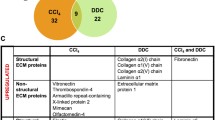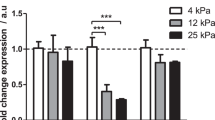Abstract
Common bile duct ligation leads to bile accumulation and liver fibrosis. In this model, little attention has been dedicated to the modification of the common bile duct. We have studied by histochemistry and immunohistochemistry, 3 and 5 days after ligation, the connective tissue modifications of the common bile duct wall. After bile duct ligation, compared with normal bile duct, a strong increase of the bile duct diameter, due to bile stasis, and a thickness of the bile duct wall were observed; numerous myofibroblasts expressing α-smooth muscle actin appeared in parallel with the detection of many proliferating connective tissue cells. These myofibroblasts secreted very early high amount of elastic fibre components, elastin and fibrillin-1. Elastic fibre increase was also observed close to the epithelial cell layer. Procollagen type III deposition was also induced 3 days after ligation but decreased thereafter, underlining that myofibroblasts modify their synthesis of extracellular matrix components to comply with the request. We show here that common bile duct ligation represents an invaluable model to study myofibroblastic differentiation and extracellular matrix adaptation produced by an acute mechanical stress.





Similar content being viewed by others
Reference
Arora PD, Narani N, McCulloch CA (1999) The compliance of collagen gels regulates transforming growth factor-beta induction of alpha-smooth muscle actin in fibroblasts. Am J Pathol 154:871–882
Darby I, Skalli O, Gabbiani G (1990) Alpha-smooth muscle actin is transiently expressed by myofibroblasts during experimental wound healing. Lab Invest 63:21–29
Desmoulière A, Geinoz A, Gabbiani F, Gabbiani G (1993) Transforming growth factor-β1 induces α-smooth muscle actin expression in granulation tissue myofibroblasts and in quiescent and growing cultured fibroblasts. J Cell Biol 122:103–111
Desmoulière A, Darby I, Costa AMA, Raccurt M, Tuchweber B, Sommer P, Gabbiani G (1997) Extracellular matrix deposition, lysyl oxydase expression, and myofibroblastic differentiation during the initial stages of cholestatic fibrosis in the rat. Lab Invest 76:765–778
Desmoulière A, Darby IA, Gabbiani G (2003) Normal and pathologic soft tissue remodeling: role of the myofibroblast, with special emphasis on liver and kidney fibrosis. Lab Invest 83:1689–1707
Dubuisson L, Lepreux S, Bioulac-Sage P, Balabaud C, Costa AMA, Rosenbaum J, Desmoulière A (2001) Expression and cellular localization of fibrillin-1 in normal and pathological human liver. J Hepatol 34:514–522
Grinnell F, Zhu M, Carlson MA, Abrams JM (1999) Release of mechanical tension triggers apoptosis of human fibroblasts in a model of regressing granulation tissue. Exp Cell Res 248:608–619
Hinz B, Gabbiani G (2003a) Cell-matrix and cell-cell contacts of myofibroblasts: role in connective tissue remodeling. Thromb Haemost 90:993–1002
Hinz B, Gabbiani G (2003b) Mechanisms of force generation and transmission by myofibroblasts. Curr Opin Biotechnol 14:538–546
Lamireau T, Dubuisson L, Lepreux S, Bioulac-Sage P, Fabre M, Rosenbaum J, Desmoulière A (2002) Abnormal hepatic expression of fibrillin-1 in children with cholestasis. Am J Surg Path 26:637–646
Lorena D, Darby IA, Reinhardt DP, Sapin V, Rosenbaum J, Desmoulière A (2004) Fibrillin-1 expression in normal and fibrotic rat liver and in cultured hepatic fibroblastic cells: modulation by mechanical stress and role in cell adhesion. Lab Invest 84:203–212
Paradis V, Dargere D, Bonvoust F, Vidaud M, Segarini P, Bedossa P (2002) Effects and regulation of connective tissue growth factor on hepatic stellate cells. Lab Invest 82:767–774
Sedlaczek N, Jia JD, Bauer M, Herbst H, Ruehl M, Hahn EG, Schuppan D (2001) Proliferating bile duct epithelial cells are a major source of connective tissue growth factor in rat biliary fibrosis. Am J Pathol 158:1239–1244
Skalli O, Ropraz P, Trzeciak A, Benzonana G, Gillessen D, Gabbiani G (1986) A monoclonal antibody against alpha-smooth muscle actin: a new probe for smooth muscle differentiation. J Cell Biol 103:2787–2796
Slott PA, Liu MH, Tavoloni N (1990) Origin, pattern, and mechanism of bile duct proliferation following biliary obstruction in the rat. Gastroenterology 99:466–477
Tomasek JJ, Gabbiani G, Hinz B, Chaponnier C, Brown RA (2002) Myofibroblasts and mechano-regulation of connective tissue remodelling. Nat Rev Mol Cell Biol 3:349–363
Tuchweber B, Desmoulière A, Bochaton-Piallat ML, Rubbia-Brandt L, Gabbiani G (1996) Proliferation and phenotypic modulation of portal fibroblasts in the early stages of cholestatic fibrosis in the rat. Lab Invest 74:265–278
Acknowledgements
This work was supported in part by Région Aquitaine. Christelle Guyot holds a fellowship from Région Aquitaine. We are very grateful to Dr. D. Hartmann (Novotec, Lyon, France) for providing antibodies against procollagen type III and elastin.
Author information
Authors and Affiliations
Corresponding author
Rights and permissions
About this article
Cite this article
Guyot, C., Combe, C. & Desmoulière, A. The common bile duct ligation in rat: a relevant in vivo model to study the role of mechanical stress on cell and matrix behaviour. Histochem Cell Biol 126, 517–523 (2006). https://doi.org/10.1007/s00418-006-0185-2
Accepted:
Published:
Issue Date:
DOI: https://doi.org/10.1007/s00418-006-0185-2




